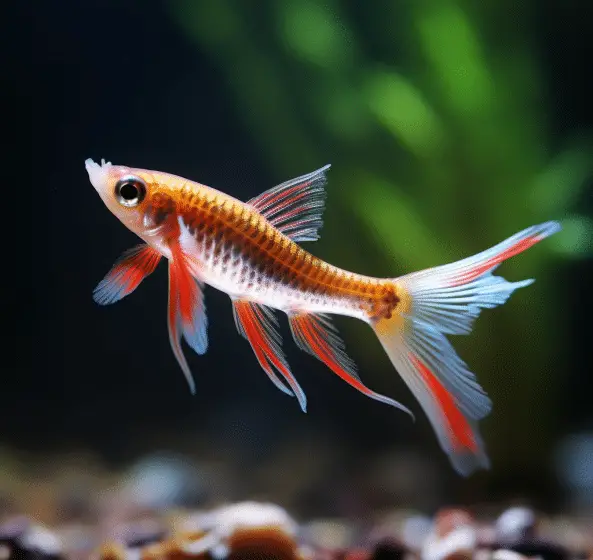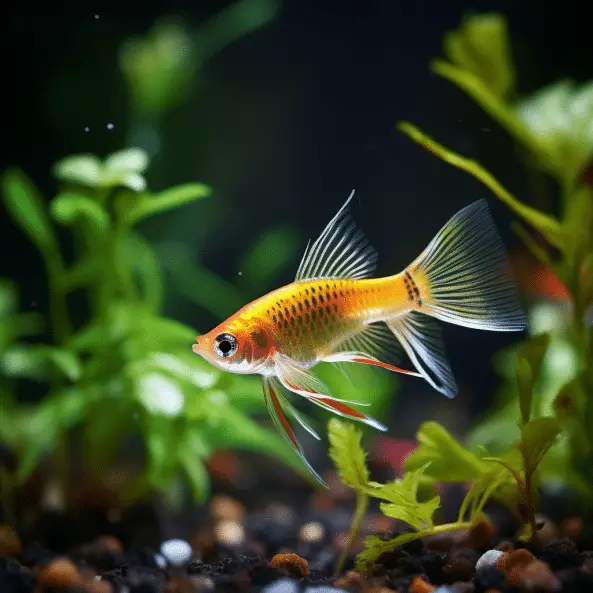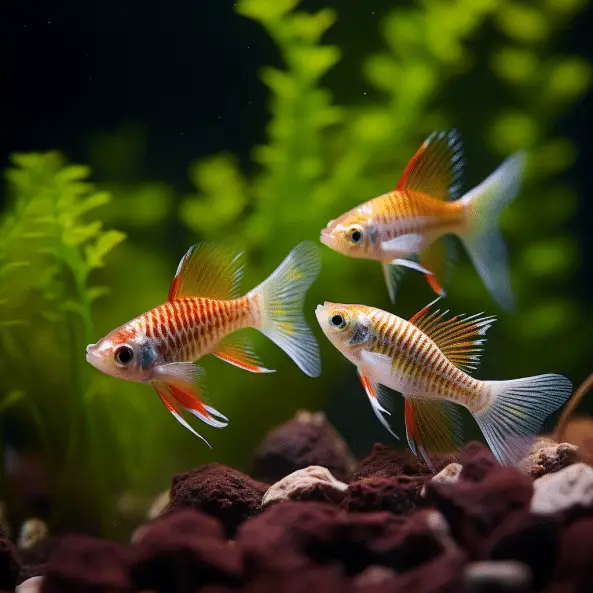Swordtails: Fascinating Livebearers in Freshwater Aquariums

Introduction
Swordtails Livebearers celebrated for their colorful appearance and active behavior, have become a staple in freshwater aquariums. The aspect that often piques the curiosity of aquarists is the method by which swordtails reproduce. In this realm of aquatic fascination, swordtail shine as livebearer. This unique trait means they give birth to live fry instead of laying eggs, setting them apart from fish species that follow the traditional egg-laying pattern.
The swordtail fish’s courtship, internal fertilization, and embryo growth are fascinating. The swordtail fish hatch live fry, small duplicates of the adult. Their livebearing nature makes swordtails a visual treat in aquariums and a source of astonishment for aquarists who get to see the birth and maturation of these small, autonomous fry.
Aquarium maintaining is more interesting and fun with swordtail as a livebearer. The breeding procedure is simplified because there are no eggs to manage, and aquarists can enjoy watching new life join their aquarium. Understanding this fascinating element of swordtails makes them a beloved addition to freshwater aquariums.
Is swordtail a livebearers?
Swordtail fish are livebearers, meaning they give birth to free-swimming fry. In appropriate conditions, they breed readily with little intervention. Feed the swordtail pair live food and gradually raise the main tank’s water temperature to 80°F.
Yes, swordtail fish are indeed livebearers. Livebearers are a group of fish species that give birth to live offspring rather than laying eggs. Swordtails are among the well-known livebearing fish species, which also include guppies, mollies, and platies. This reproductive method is one of the key characteristics that make swordtail and other livebearer popular in the aquarium hobby.
Swordtail females commonly produce live fry, smaller copies of the adult fish. A placenta-like structure feeds the fry inside the mother. As the fry mature, the female gives birth to free-swimming swordtails. This unique reproductive mechanism makes aquarists excited to see the fry grow in their tanks.
Swordtail fish are popular with aquarists due to their livebearing nature, beautiful colors, and active temperament. It also makes them easy to breed in captivity, and their adaptability to different water conditions makes them appealing to both novice and experienced fishkeepers.

Can swordtails live with soft water?
Water Quality
Swordtails prefer hard, basic water, unlike many other tank fish. The species is resilient and doesn’t care much about water quality. Aim for 7-8 pH and 100-450 hardness.
Swordtail fish can survive in soft and hard water. They are popular in aquariums because they can thrive in many settings.
Swordtails thrive in soft water with minimal mineral content and hardness, as long as water quality is stable and temperature and pH are adequate. Soft water has a lower pH and is found in low-dissolved mineral areas.
Swordtails’ demands differ by origin. The swordtail kind you’re raising may favor different water conditions, so research them and try to mimic their natural habitat. Whether you have soft or hard water in your aquarium, swordtails’ health and behavior depend on stable water parameters, regular water changes, and monitoring.
Do swordtails give live birth?
Like other livebearing aquarium fish, swordtails (Xiphophorus hellerii) give birth to live young, or fry, rather than laying eggs. Although the swordtail’s gestation period is 28 days, it may be difficult to determine when she became pregnant.
Yes, swordtail fish are livebearers, meaning they give birth to live offspring rather than laying eggs. This is one of their distinguishing characteristics that sets them apart from egg-laying fish species. Swordtail females possess a unique reproductive system, which allows them to produce live fry.
The reproductive process in swordtails involves internal fertilization. Mating occurs when the male transfers sperm to the female through a specialized fin called a gonopodium. The female then carries the fertilized eggs inside her body, where the developing fry are nourished by a placenta-like structure. Once the fry are fully developed and ready to swim independently, the female gives birth to live, free-swimming baby swordtails.
This livebearing reproductive strategy is fascinating to observe in home aquariums, as it allows aquarists to witness the birth of the fry and the subsequent growth and development of the young swordtail fish. It also makes breeding swordtails relatively straightforward, as there is no need to separate the eggs or provide special care for the fry immediately after birth, as is the case with egg-laying fish species.
How long do female swordtails live?
Experts recommend keeping a ratio of three females to one male to help keep the peace. The average swordtail fish lifespan is 3 to 5 years.
The lifespan of female swordtail fish can vary depending on several factors, including their environment, care, and genetics. In well-maintained aquariums, female swordtails typically have a lifespan of about two to three years. However, some may live longer if they are provided with optimal conditions and proper care.
Water quality is vital to their longevity. Female swordtails need a clean, well-balanced aquarium with regular water changes and adequate filtration to thrive. This species also needs suitable water factors including temperature and pH.
Genetics and health also matter. Healthy fish produced in appropriate conditions live longer. A balanced diet and stress-free environment can also help female swordtails live longer. Aquarists may assist female swordtail fish have long and healthy lives in their aquariums by prioritizing their care and considering these considerations.
What do baby swordfish look like?
When swordfish eggs hatch the larvae have a short snout and prickly scales. They measure about 4 mm long and are pelagic, or open-water, larvae.
Baby swordtail fish, also known as fry, are miniature versions of the adult swordtail fish, albeit with a few distinct features. When they are born, they are tiny and delicate, measuring around 0.2 to 0.4 inches (5-10 millimeters) in length. Their appearance and characteristics include:
- Miniature Size: Baby swordtails are incredibly small when they are born, and their size can make them appear fragile. Their bodies are slender, and they lack the elongated sword-like extension that distinguishes adult male swordtails.
- Coloration: The coloration of baby swordtail fish is often paler and less vibrant than that of their adult counterparts. They might appear more translucent or silverish when they are first born. As they grow and mature, their colors become more vibrant and develop the characteristic hues found in adult swordtail fish, such as red, orange, and black.
- No Swords: The most notable feature of baby swordtails is the absence of the distinct sword-like extension that adult male swordtails possess. This feature only develops as they mature, and it’s a characteristic specific to the males. Female swordtail fry do not develop swords.
As the baby swordtail fish continue to grow and develop, their colors become more pronounced, and their bodies take on the distinctive appearance of their adult counterparts. Providing proper care and a well-maintained aquarium environment is essential for the healthy growth and development of these young fish.
Are swordtail fish livebearers or egg layers?
Swordtail fish are classified as livebearers, which means they give birth to live offspring rather than laying eggs. This is one of the key distinguishing characteristics of livebearing fish species, and swordtails are a prime example. Livebearing fish, also known as ovoviviparous fish, carry their developing embryos inside their bodies and give birth to fully formed, live fry.
In the case of swordtail fish, reproduction involves internal fertilization. The male swordtail transfers sperm to the female through a specialized fin called a gonopodium. The female then carries the fertilized eggs, or embryos, inside her body during their development. These embryos are nourished by a placenta-like structure, which provides them with the essential nutrients required for growth. Once the fry are fully developed, the female swordtail gives birth to live, free-swimming baby swordtails.
The livebearing nature of swordtail fish, along with their colorful appearance and active behavior, contributes to their popularity among aquarium enthusiasts. It also simplifies breeding and raising offspring, as there is no need to deal with eggs or provide special care for newly hatched fry, as is the case with egg-laying fish species.
What is the reproductive method of swordtail fish?
The reproductive method of swordtail fish is unique and falls under the category of livebearing, also known as ovoviviparity. This means that swordtail fish give birth to live fry rather than laying eggs. The reproductive process involves several stages:
- Courtship and Mating: The courtship rituals of swordtail fish are notable for their vibrant displays. Male swordtails use their sword-like tails, which are elongated and often brightly colored, to court and attract females. When a female is receptive to mating, the male transfers sperm to the female’s body using a specialized fin called the gonopodium.
- Internal Development: Once the female is fertilized, she carries the fertilized eggs, or embryos, within her body. The embryos develop inside the female, receiving nourishment through a placenta-like structure, which provides them with essential nutrients for growth. The development period can vary, but typically it takes several weeks for the embryos to reach a stage where they are ready to be born.
- When fry are completely formed and ready to swim independently, the female swordtail gives birth to live spawn. The fry, little swordtail fish, can swim and hunt on their own. Swordtail females can have a dozen to over 100 fry, depending on their size and age.
Aquarists may see fry hatch and grow in their aquariums thanks to this unique reproductive mechanism. Hatching swordtail fish in captivity is easier because eggs are not needed and the fry are fully formed and ready to explore.
Do swordtails give birth to live fry or lay eggs?
Swordtail fish, like other livebearing fish species, give birth to live fry rather than laying eggs. This is a distinctive feature that sets them apart from egg-laying fish. Swordtail are categorized as livebearer because their reproductive process involves internal fertilization and the development of embryos inside the female’s body.
The reproductive process of swordtail fish includes courtship and mating, during which the male transfers sperm to the female using a specialized fin known as the gonopodium. Once fertilization occurs, the female carries the fertilized eggs, or embryos, within her body. These developing embryos are nourished through a placenta-like structure. When the fry are fully developed, the female swordtail gives birth to live, free-swimming baby swordtails. These fry are miniature versions of the adult fish, and they are immediately capable of swimming and seeking food on their own.
The livebearing nature of swordtail fish simplifies the process of breeding them in home aquariums, as there is no need to manage or care for eggs, and the fry are born fully formed and ready to explore their aquatic environment. This unique reproductive method is a fascinating aspect of swordtail fish and contributes to their popularity among aquarists.

Conclusion
The distinction between livebearing and egg-laying fish is a crucial aspect of understanding the nature of swordtail fish. Swordtail are unequivocally classified as livebearer, giving birth to live fry rather than laying eggs. This unique reproductive strategy sets them apart from many other aquarium species and adds an extra layer of fascination for aquarists.
The livebearing nature of swordtail fish contributes to their popularity among aquarium enthusiasts. It simplifies the process of breeding them in captivity, as there is no need to manage or care for eggs, and the fry are born fully formed and ready to explore their aquatic surroundings. This quality makes swordtails a great choice for both beginner and experienced aquarists, as it allows for the joyful experience of witnessing the birth and growth of fry in a home aquarium.
As exploration of swordtail as livebearer it’s evident that understanding their unique reproductive method is essential for providing appropriate care and appreciating the captivating aspects of these fish. Swordtail continue to be celebrated not only for their striking colors and lively behavior but also for the intriguing dimension of their livebearing nature, making them a beloved addition to the world of freshwater aquariums.



